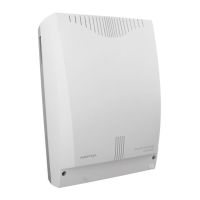Ascotel IntelliGate 2025/2045/2065
702 Planning a private network Part 3
4. In addition, however, the parameter "Send Access Code" is configured with
digit "0" in route 1. This is the exchange access prefix for the Centrex.
If a subscriber in system 1 dials the exchange access prefix 0 followed by the pub-
lic number, e.g. 032 6241399, system 1 will seize a line from route 1 and imme-
diately dial the digits entered under "Send Access Code", i.e. in this case "0".
Only then does the public number follow. Centrex sets up a connection to the
public network.
Note:
Calls from the public network reach system 1 via Centrex. The CLIP
number is preceded by an exchange access prefix as system 1 is simply
an internal subscriber from Centrex's point of view. For the CLIP to be
correctly displayed on system 1, the exchange access prefix needs to be
deleted again from the PBX. To this end, "Truncate CLIP = 0" is entered
in the corresponding trunk group. This means that when a CLIP number
beginning with "0" is received, the "0" is truncated.
6.5 Networking with third-party systems
In principle all network-compatible third-party systems that support the QSIG
standard can be networked with the system. However, some restrictions in the
features available are possible. A number of points need to be taken into account
for a third-party system to communicate correctly with the system.
6.5.1 Compatible QSIG protocol
In practice two different QSIG protocols are used, QSIG and QSIG / PSS1 ISO. The
two variants differ only with regard to the communication technology, not the
scope of performance. The system supports both versions. They can be selected
under the "Protocol" trunk group setting. Make sure you always use the same
version between two systems.
6.5.2 Outgoing calls via a third-party system
There are instances where third-party systems do not recognize a call to be for-
warded to the public network based on its numbering plan identifier. For this rea-
son an exchange access prefix for the third-party system should be sent with the
call (see variant 2 on page 687).

